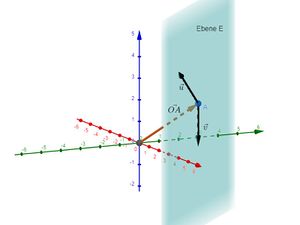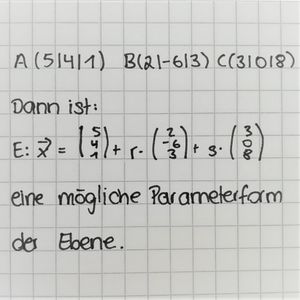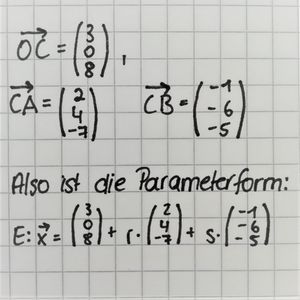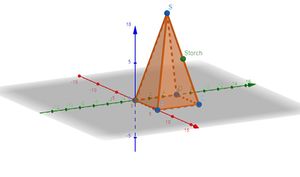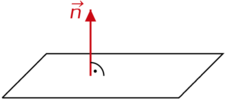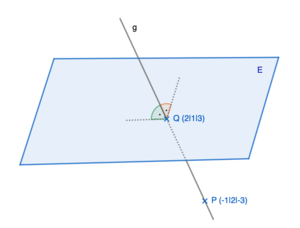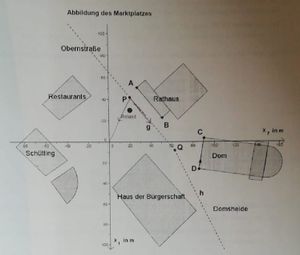Digitale Werkzeuge in der Schule/Unterwegs in 3-D – Punkte, Vektoren, Geraden und Ebenen im Raum/Ebenen im Raum: Unterschied zwischen den Versionen
Aus ZUM Projektwiki
< Digitale Werkzeuge in der Schule | Unterwegs in 3-D – Punkte, Vektoren, Geraden und Ebenen im Raum
Markierung: Quelltext-Bearbeitung 2017 |
Markierung: Quelltext-Bearbeitung 2017 |
||
| Zeile 419: | Zeile 419: | ||
===⭐Überführung der Parameterform in die Koordinatenform=== | ===⭐Überführung der Parameterform in die Koordinatenform=== | ||
<br />{{Box | Beispiel: Von der Parameter- zur Koordinatenform einer Ebenengleichung | Wir suchen die Koordinatengleichung der Ebene <math>E: \vec{x} = \begin{pmatrix} 2 \\ 1 \\ 5 \end{pmatrix} + s \cdot \begin{pmatrix} 1 \\ -1 \\ 0 \end{pmatrix}+ t \cdot \begin{pmatrix} 1 \\ -3 \\ 4 \end{pmatrix}</math>. Ein Normalenvektor <math>\vec{n}=\begin{pmatrix} 2 \\ -1 \\ 5 \end{pmatrix}</math> muss zu den Spannvektoren <math>\begin{pmatrix} 1 \\ -1 \\ 0 \end{pmatrix}</math> und <math>\begin{pmatrix} 1 \\ -3 \\ 4 \end{pmatrix}</math> orthogonal (senkrecht) sein, also ist <math>\begin{pmatrix} n_1 \\ n_2 \\ n_3 \end{pmatrix} \cdot \begin{pmatrix} 1 \\ -1 \\ 0 \end{pmatrix}=0</math> und <math>\begin{pmatrix} n_1 \\ n_2 \\ n_3 \end{pmatrix} \cdot \begin{pmatrix} 1 \\ -3 \\ 4 \end{pmatrix}=0</math>. Hieraus folgt <math>n_1-n_2=0</math> <math>n_1-3n_2+4n_3 =0</math> und daraus XYZXYZ. Wählt man z.B. <math>n_2=2</math>, so erhält man <math>n_1=2</math> und <math>n_3=1</math> und damit <math>\vec{n}=\begin{pmatrix} 2 \\ 2 \\ 1 \end{pmatrix}</math>. Ansatz für die Koordinatengleichung: <math>E:2x_1+2x_2+x_3=d</math>. Man berechnet <math>d</math> indem man für <math>x_1, x_2</math> und <math>x_3</math> die Koordinaten des Stützvektors von E einsetzt: <math>d=2 \cdot 2 + 2 \cdot 1 + 1 \cdot 5=11</math>. Koordinatengleichung: <math>E:2x_1+2x_2+x_3=11</math>| Hervorhebung1}} | <br />{{Box | Beispiel: Von der Parameter- zur Koordinatenform einer Ebenengleichung | Wir suchen die Koordinatengleichung der Ebene <math>E: \vec{x} = \begin{pmatrix} 2 \\ 1 \\ 5 \end{pmatrix} + s \cdot \begin{pmatrix} 1 \\ -1 \\ 0 \end{pmatrix}+ t \cdot \begin{pmatrix} 1 \\ -3 \\ 4 \end{pmatrix}</math>. | ||
Ein Normalenvektor <math>\vec{n}=\begin{pmatrix} 2 \\ -1 \\ 5 \end{pmatrix}</math> muss zu den Spannvektoren <math>\begin{pmatrix} 1 \\ -1 \\ 0 \end{pmatrix}</math> und <math>\begin{pmatrix} 1 \\ -3 \\ 4 \end{pmatrix}</math> orthogonal (senkrecht) sein, also ist <math>\begin{pmatrix} n_1 \\ n_2 \\ n_3 \end{pmatrix} \cdot \begin{pmatrix} 1 \\ -1 \\ 0 \end{pmatrix}=0</math> und <math>\begin{pmatrix} n_1 \\ n_2 \\ n_3 \end{pmatrix} \cdot \begin{pmatrix} 1 \\ -3 \\ 4 \end{pmatrix}=0</math>. | |||
Hieraus folgt <math>n_1-n_2=0</math> <math>n_1-3n_2+4n_3 =0</math> und daraus XYZXYZ. Wählt man z.B. <math>n_2=2</math>, so erhält man <math>n_1=2</math> und <math>n_3=1</math> und damit <math>\vec{n}=\begin{pmatrix} 2 \\ 2 \\ 1 \end{pmatrix}</math>. | |||
Ansatz für die Koordinatengleichung: <math>E:2x_1+2x_2+x_3=d</math>. | |||
Man berechnet <math>d</math> indem man für <math>x_1, x_2</math> und <math>x_3</math> die Koordinaten des Stützvektors von E einsetzt: <math>d=2 \cdot 2 + 2 \cdot 1 + 1 \cdot 5=11</math>. | |||
Koordinatengleichung: <math>E:2x_1+2x_2+x_3=11</math>| Hervorhebung1}} | |||
{{Box | ⭐Aufgabe 16: Koordinatengleichung aus Parametergleichung | | {{Box | ⭐Aufgabe 16: Koordinatengleichung aus Parametergleichung | | ||
Version vom 18. Juni 2021, 09:12 Uhr
Die Parameterform und die Punktprobe
Die Punktprobe
⭐ Normalenvektor
⭐ Normalenform und Koordinatenform von Ebenengleichungen
⭐Überführung der Parameterform in die Koordinatenform

